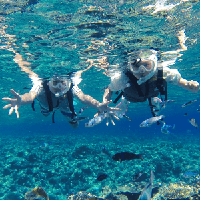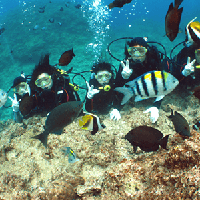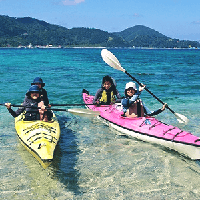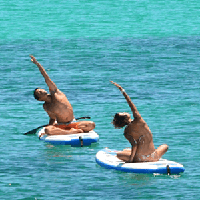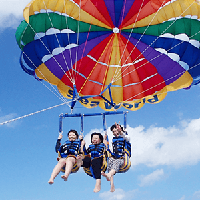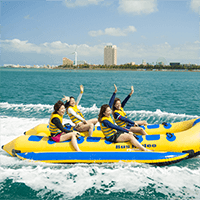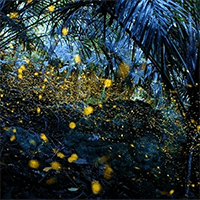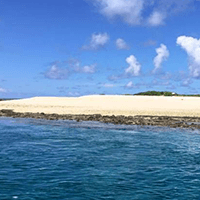List of Ie Island
- Age 3~Age 70
- 2~3 hours
- 09:00 / 11:30 / 14:00 / 16:30
Held from spring to autumn Fishing for Japanese eels in the brackish waters of rivers Part 1: 8:00-10:30 Part 2: 10:30-13:00 Part 3: 13:30-16:00 Part 4: 16:00-18:30 This is a tour to fish for eels at the mouths of rivers that run through Tokyo. Japanese eels are born in the western waters of the Mariana Islands. They grow in rivers not only in Japan but also in East Asia, including China, Taiwan, and the Korean Peninsula, and are known to return to the Mariana Islands to spawn. Japanese eels (Anguilla japonica), which belong to the Anguilla genus of the eel family, are widely distributed in East Asia, including Japan, China, Taiwan, and Korea. In Japan, they mainly live south of Honshu, but there have been cases of them being caught in Hokkaido. Rental tackle, fishing rod, and equipment are included, so you can participate empty-handed. Two patterns of fishing will be done: casting fishing and plastic bottle tackle fishing, using earthworms as bait. While waiting for the tackle, you can fish for goby at your feet. The main target is eels, but sometimes you can also catch goby, crabs, and seigo. The tour lasts about 3 hours. Please bring a headlamp, a handy light, and drinks. *If you want to take the fish home, please bring an aeration device (battery-powered bubbler) to prevent oxygen deficiency, a plastic case or fishing bucket to prevent escape, and a cooler box. By train: 15 minutes walk from JR Joban Line or Tokyo Metro Chiyoda Line By car: Please use a nearby parking lot Meeting place: Near the Seven-Eleven Katsushika Kosuge 1-chome store. We will send you a map in advance, so please walk to the point. Migration of Japanese eels Japanese eels spawn in the summer in the waters west of the Mariana Islands in the Pacific Ocean. After hatching, they become willow-leaf-shaped larvae called leptocephalus. Glass eels are carried by ocean currents and reach East Asia in about six months, then transform into long, cylindrical glass eels and ride the high tide into rivers. After that, their transparent bodies start to take on color, and they are called yellow eels. During the yellow eel stage, eels grow large, and eat a variety of foods, including shrimp, crabs, small fish, and insects. The environment in which Japanese eels spend their growth period is wide, from coastal areas to the upper reaches of rivers, and includes not only freshwater areas but also brackish water and seawater. After several years to a dozen years, when they grow to a size of about 40 cm or more for males and about 50 cm or more for females, they begin to mature and are called silver eels. Silver eels leave their familiar rivers and coastal areas and travel to spawning grounds from autumn to winter. They reach the spawning grounds in the Marianas in about six months, spawn, and then end their life. PS: The minimum number of participants is 5 or more.
- Age 6~Age 75
- Over 6 hours on the day
It is a tour around the battle site where many memories sleep while considering the horror of war and the importance of peace. Ogasawara An investigator in the village battlefield survey report is guiding. The battlefield guide has visited many of the Japan battlefields in the north to Hakodate Battery and in the south to Okinawa Main Island.
- Age 20~Age 100
- 2~3 hours
- 09:00 / 13:00
A jungle island with a virgin forest with a subtropical climate Ogasawara So you can enjoy the majestic nature of nature. The main courses are Heart Rock (Shirahiroiwa), Akagashirakarasubatto Sanctuary, Ulsan, Red Flag Mountain, Umbrella Mountain, Hatsuri, Mt. Crescent, Asahiyama, Chuoyama etc. The weather is cool and easy to walk in the best season Nov. It is ~ May. other Activity For those who want to experience or have plans for sightseeing half-day I recommend a course.
良いガイドさんとマンツーマンで半日楽しくトレッキングができ、東平カラスバトサンクチュア利では固有種?のカタツムリも見られました。最高!他にも中央山、傘山は説明が良かった。トレッキングが危険度中の少。楽しくトレッキングができました。
最近チェックしたプラン
Please wait a moment
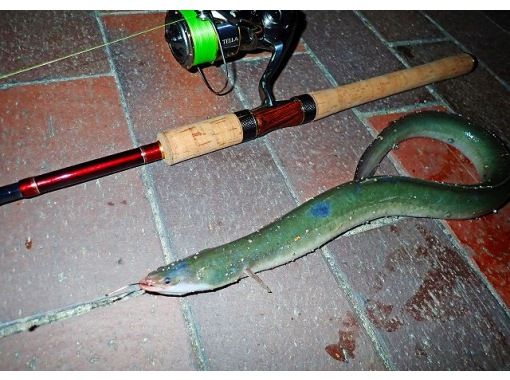
![[Chichijima, Ogasawara Tokyo] Adventure tour (1 day course) around Ogasawara where the memories of the war ruins sleepの画像](https://img.activityjapan.com/10/6761/10000000676101_bV75BaJT_3.jpg?version=1570068505)
![[Tokyo Ogasawara] Jungle trekking on the Ogasawara island-a simple plan of half-day course with guidance by guide!の画像](https://img.activityjapan.com/10/5899/10000000589901_pbazU8ET_3.jpg?version=1569382206)
